Schienenpanzer 204(f)
 Nazi Germany - 43 converted in 1941.
Nazi Germany - 43 converted in 1941.
A rail-adapted variant of the Panhard 178
The French AMD-35

The Panhard 178 (factory designation) or AMD-35 (Army designation) for "automitrailleuse de découverte" (lit. "discovery"(reconnaissance) armoured car) was probably among the very best vehicles of that type deployed when WW2 broke out in 1939. Probably better suited to high speed forays due to their wheels than French cavalry tankettes also deployed (they were twice as fast), they were developed from 1931 for a Cavalry specification, and tested extensively in 1934 by the Commission de Vincennes before acceptation in 1935. They had a lot of limitations however, but still were chosen as the best of the prototypes.
Orders were placed to Panhard but as usual 1936 great strikes disruption made sure that only a fraction were available in late 1938 with the bulk arriving in 1939-40, and until the invasion in May, perhaps 370 were available, directed to their respective units with little-trained crews, and 429 delivered by the time of the Armistice (553 grand total, 124 hulls without turrets). The "Pan-Pan" proved a formidable asset for Cavalry. The first served with the 6e Cuirassiers in 1937 for field evaluation and the 21e Escadron (later 4e GRDI) in 1940 saw action in Norway. The rest were consumed in the brasero of the May-June desperate combats, inside reconnaissance squadrons organic to mechanized and armored divisions, Divisions Légères Mécaniques (DLM, 40 vehicles each), and the Divisions Légères de Cavalerie (DLC) had 12+1+4 (1 long range radio, 4 reserve).
German use

Past the June armistice, a German commission was created by the waffenamt to count all captured French vehicles and list those in good condition, leaving the rest to Vichy. In total 729 had been built all told, 176 under the German occupation in 1940. 190 vehicles (most being factory new) and those caught in depots waiting for crews in June, were requisitioned and called Panzerspähwagen P204 (f). Before re-entering service they needed detail modifications: New coaxial LMG, new German long range radios (some were even fitted with the "bedframe" antenna type), and german texts on many displays and commands. After being tested extensively, they were judged equal or inferior to the Sd.Kfz.221-23 family and saw heavy action during Operation Barbarossa where the bulk went. 107 were lost already by in 1941 however due to the combinaiton of heavy mud and light protection (standard infantry PTR-S rifles could easily pierce them). However they were criticized for their short range, an inheritance of French pre-1939 thinking.

While a great numbers were lost it was decided by late 1941 or 1942 to convert extra vehicles as Panzerspähwagen (Funk) P204 (f) with their caracteristic bed frame antenna. These were still soldiering by 1943 on the Eastern Front but many surviving vehicles received spaced armor. 43 more were converted as railway patrollers (Schienenpanzer). Most were also fitted with the "bedframe" radio antenna to patrol the rear lines in conquered territories, adapted to the local gauge and convertible back if needed. The remainder 34 were seized in November 1942 during the full occupation of France (The Vichy regime used 64 vehicles for police duties) and the MG-only armed vehicle were converted as 50 mm gun-armed support vehicles, soldiering on during the Normandy invasion and operations in France.
German Variants
Panzerspähwagen 178 P204(f) or P204(f): Wehrmacht basic captured numerous Panhard 178s refitted with German radios and MG34 coaxial LMGs were available. Well appreciated for the punch of their 20 mm gun and speed. They were used until spare parts ran dry.Schienenpanzer P 204(f): Post-1941 modification of 43 wheeled vehicles into railway protection vehicles that could travel on rails and also had larger radio antennas. "204" designator was purely an administrative follow-up number, "F" was for "Frankreich"
P 204 (f) mit 5cm KwK: In 1944, 34 vehicles focibly requisitioned during the occupation of Vichy France in 1942 were equipped with 50 mm Kanone L/42 or L/60 guns in an open turret, used for reconnaissance fire support vehicles, anti-partisan warfare mostly.
Specifics of the Schienenpanzer 204(f)
Converting the vehicles was relatively easy. The idea of taking out a regular armored car for railroad service was not new. The Japanese became adept in the concept, notably with vehicles such as the Type 94 Sumida which was basically a convertible 6x6 rail/road convertible armoured car also called type 93 So-Mo. The basic modification however was wanted quickly and conversion was seen as one-ticket. These 40 or 43 captured Panhard 178s were converted with the late type APX3 turrets before other mofifications, and compared to the earlier models which lacked a rear view episcope, the new machines had two Gundlach periscopes mounted on the turret roof.The vehicles were modified so that the wheels could be changed from rail to roadwheels in about ten minutes making these very versatile and highly mobile vehicle. Engineers did the same simple conversion with the many captured Soviet BA-20s as the Panzerspähwagen BA 202(r) Schienenpanzer. It consisted in retiring the tyres and welding on the internal track standard gauge railroad soft-metal rimmed wheels. Further modifications were made down the line: A searchlight was requested for all 8 Pz.Sp.Wg. of Eisenbahn Panzertriebwagen 15 on October 31st, 1943 to better see the railroad by night, most likely time fo saboteurs, and thus, for effective patrols. Additionally, it was asked to add a red/green light switch for the commanders and drivers for minimal communication due to very loud engine noise according to the OKH report. No intercom was installed of course, reserved to frontline tanks. A green flashing light meant more speed, flashing red lights, lower speeds, red light equals stop, green light equals, keep the speed, and no light: Shut the engine off.
The rest of the vehicle was mostly unchanged: The basic Panhard 178 was straithfoward, riveted built with a crew of four, the driver forward, commander and gunner in the turret and the radio operator/passenger seated below it, which can double as rear driver, where he was seated. The engine compartment (engine and transmission behing, rear propulsion were located into the right side of the hull. The rear driver position was to its left, facing backwards. The vehicle's dimensions were moderate, at 4.79 m (including cannon) 2.01 m in width and 2.31 m in height (three meters with the bedframe antenna) for a combat ready mass of 8.2 tons. Armor was limited to 20 mm (1.1 in) on the hull forward arc and 16 mm all around, 26 mm for the turret front, sufficient against small and heavier arms fire and shrapnel.
Its main armament was originally a 25 mm SA-35 cannon. Its performances were considered good enough to be be replaced by the German equivalent, which would have cause significant delays in adaptation. The secondary armament was a 7.55mm Reibel machine gun and for commonality it is likely (but not certain) that it was replaced by a MG.43. The vehicle was low, nimble, agile, and fast, which were above all its main qualities, despite a modest 4-cylinders in vee 105 hp Panhard ISK4-V4 which enabled it to reach 72 kph on road, over a range of 300 km based on a 145 liters main gasoline tank. The gearbox also allowed for a 42 kph in emergency reverse, which was also appreciable on railroad use, added to the rear driver. Now, on rails these performances were in theory greater, as long as friction in virages and the nature of the track allowed it (vibrations, tolerances...), so both the top speed in favourable conditions and range were much greater than a standard all-terrain use.
Combat Use

As said above, "only" 43 were converted, and sent to the Eastern Front which gauge track was different than in the west. This prevented the use of these vehicles anywhere but in Russian alone. Given the Russian railroad network at the time, and gradual advance of the German Army to the Volga, this enabled from the northern (Leningrad front) to the south front and black sea quite an extensive network to criss-cross. The western part of Russian was especially well covered, up to the Ural, and to the Volga, with perhaps 100,000 km or railroad. If the Russian destroyed these systematically during their retrat eastwards, German specialized teams from the Deutsche Reichsbahn detached to the Wehrmacht, tasked of the logistics, were in charge of these repairs and sometimes created entire new lines, this time on German gauge during and after Operation Barbarossa. Field railways were subordinated to the Master of Field Railways (Chef des Feldeisenbahnwesens or FECH) bu railways troops were deployed to protect the Deutsche Reichsbahn during the Second World War.
Tactically these vehicles were used in Sc.Pz.Spähwagen (Eisenbahn Panzertriebwagen) units of six vehicles made of three Gruppe of two on the same line, ensuring one of each was always in circulation (day/night) while the other was in maintenance and crew's rest. The fortunes of war saw the Schienenpanzer 204(f) were thus, linked to the advances of the Wehrmacht until 1943, and then gradual withdrawal, until the last were destroyed in 1945. Thus their action when pressed onto the frontline was to scout ahead until the railroads were found sabotaged. But most of the time when the front started to froze in the winter 1941-42 and 42-43, they were mostly used to patrol the lines after repairs, and prevent notably further sabotages by the partisans.




Unidentified variants, pinterest
Gallery
Illustrations
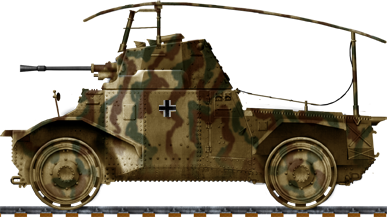
Camouflaged Schienenpanzer 204(f), Ostfront summer 1942
Photos
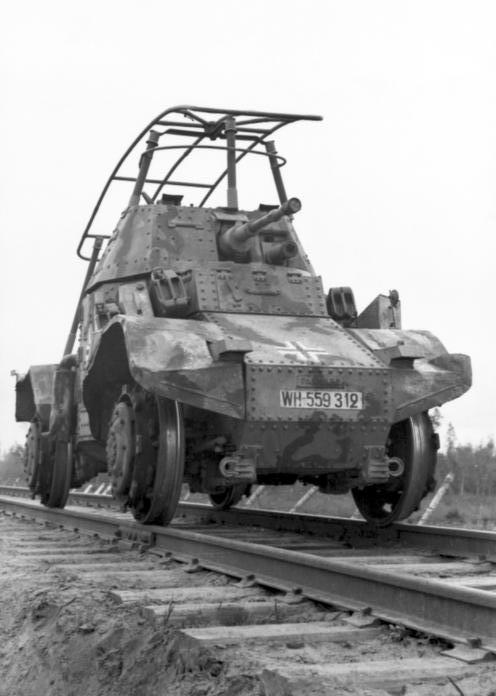
Bundesarchiv - Eastern front vehicle
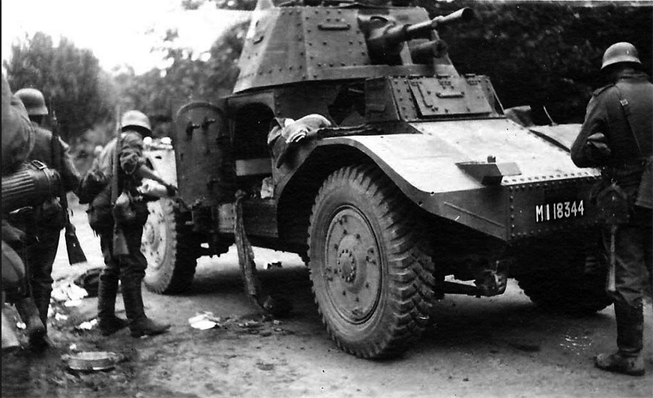
Captured vehicle
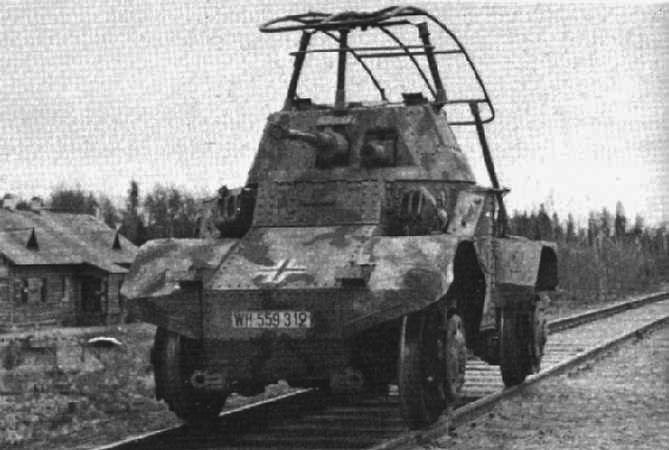
Unknown location
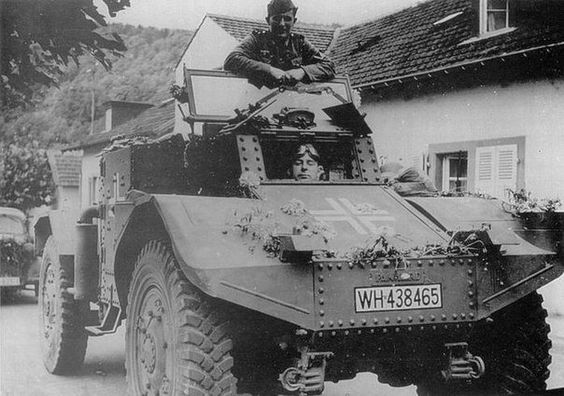
Captured 204(f)
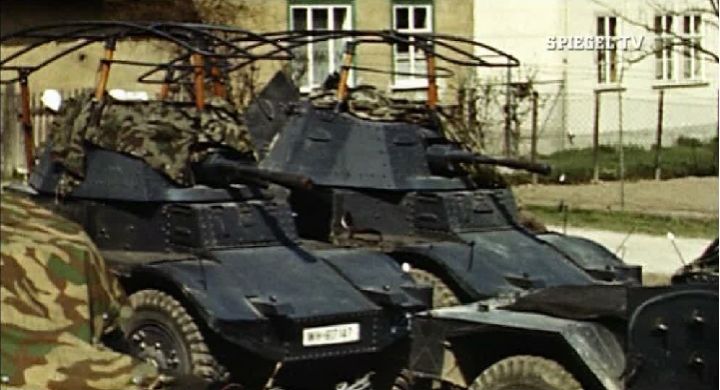
Two schienepanzer, footage extract
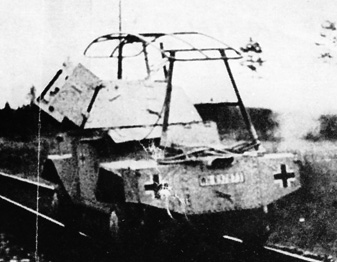
Panhard 178, David Haugh coll.
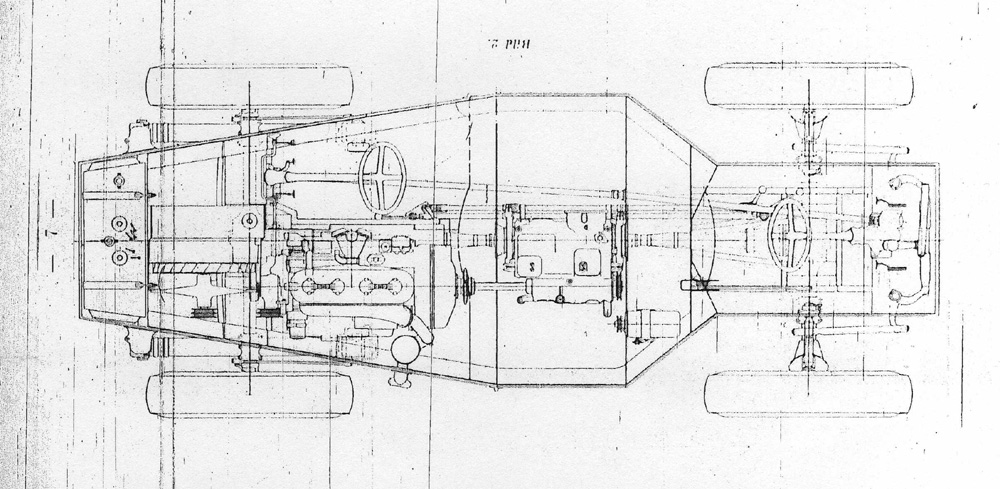
Chassis plans. More on armorama (link below)
Read More/Src
Links
wwii.germandocsinrussia.org
chars-francais.net/
niehorster.org GERMAN WORLD WAR II ORGANIZATIONAL SERIES
worldwarphotos.info
materielsterrestres39-45.fr
Videos
Model Kits
Best resources i found on the matter, armorama.com- Baldwin Railroad battery 1861
- No 6 Garrison Arm. Train 1894
- Ladysmith Train 1899
- Crewe Works 1915 coastal train
- French mobile artillery battery (1914)
- Royal Navy armoured Train 1914
- Regia Marina Arm. Trains 1915-18
- Ajmer arm. trains 1916
- Hungarian MAVAG train
- German Panzerzug Ost (1916)
- Bolshevik Armored Tram 1917
- Finnish Arm. Train (1918)
- Zaamurets (Orlík, BP-4, Lenin)
- Khunkhuz
- General Annenkov
- Yenisei
- Amur
- Terek
- Don
- Dywizja Syberyjska trains 1918
- Kozak
- Piłsudczyk
- PP3
- Gromobój
- Pionier
- Śmiały
- Lis-Kula
- Hallerczyk
- Stefan Batory
- Generał Iwaszkiewicz
- Chrobry
- Wilk
- Danuta
- Poznańczyk
- Kaniów
- Zawisza Czarny
- Zagończyk
- Paderewski
- Mściciel
- Reduta Ordona
- Huragan
- Podhalanin
- Bartosz Głowacki
- Pierwszy Marszałek
- Groźny
- Śmierć
- Śmigły
- Stefan Czarniecki
- Generał Sosnkowski
- Putilov armoured trains
- Izhorskiy Armored Train
- Czechoslovak Legion Trains
- Estonian Trains
- Lithuanian Trains
- Zhang Zongchang Train
- Danuta
- Poznańczyk
- Generał Sosnkowski
- Paderewski
- Śmierć
- Pierwszy Marszałek
- Piłsudczyk
- Śmiały
- Groźny
- Bartosz Głowacki
- Smok Kaszubski
- Drezyna R
- Drezyna TK/TKS
- UK dywizjon Trains
- SOK Draisines 1945
- Arm. draisine Crochat
- Austro-Daimler Draisine
- Armoured draisine Tatra T18
- MBV-2 Rail cruiser
- D-2 Draisine (MBV-31)
- D-37 Draisines
- Krasnaja Zvezda (KZ-1)
- D-3 Draisines
- BTD heavy Draisines (5)
- CB-1 Draisines
- DT-45 Draisines
- BD-41 Draisines (12)
- BA-I-Zhd Railcar
- BA-6ZhD Railcar
- BA-20ZhD Railcar
- BA-10Zhd Railcar
- VS-60 Train/Wagon
- BP-35L/H Train
- NKPS-42/Wagon Train (40)
- PL-35 Arty Wagon
- PL-37 Arty Wagon
- PT-35 Arty Wagon
- KV-1 Arty Wagon
- Crimean 76mm univ. Wagon
- "Tank" Wagon
- BP-42 Train/PL-42 Wagon (10)
- BP-43 Train/Wagon (54)
- 7.62mm Maxim SPU-BP Flak wagon (28)
- 37mm PVO-4 FLAK Wagon (120)
- OB-3 Light Wagon
- 27th Div armoured Trains
- 29th Div armoured Trains
- 48th Arm. Div armoured Trains
- "Stalinets" armoured Train
- "Mir Jafar Bagirov" armoured Train
- "Kozma Minin" armoured Train
- "Dzerzhinets" armoured Train
- "Za Rodinu!" armoured Train
- "Kolomensky Rabochy" armoured Train
- Zenitnyy (AA) armoured Trains
- Goering's Asien
- BP42 armoured train (full)
- BP44 armoured train (full)
- Panzerjägerwagen BP44
- BR 52, Steyr Schwerer Schienen Panzer
- Schwerer gustav Train
- P204(f) rail tank
- Schienenkampfwagen SK 1
- Schwerer Spähzug (s.Sp.) Artilleriewagen
- LeichteSchienenkampfwagen 43
- Zeppelin Panzer Draisine
- Panzertriebwagen N17
- Panzertriebwagen N16
- Panzer Draisine Funkwagen
- Panzerdraisine/Pz.III turm
- Panzerdraisine/Pz.IV turm
- Panzer Draisine Le.Sp.
- Panzer Draisine Flakvierling
- S.Panzer Draisine Kugelblitz
- L2670 leichtes panzertriebwagen
- AB Ferroviana
- Littorina OM 36
- LiBli 42
- Type K2 Steam Locomotive No.134
- Type C56 Steam Locomotive No.31
- Type 90 240 mm Railway Cannon (Futtsu Cannon)
- Type 91 Broad-gauge Railroad Tractor (So-Mo)
- Type 94 Armoured Train
- Type 95 Armoured Railroad Car (So-Ki)
- Type 98 Railroad Tractor
- Type 100 Railroad Tractor
- Type 2598 Railroad Car
- Rinji Soko Ressha 1933
- 1940 coastal defence Trains
- Royal Armoured Corps Trains
- Romney, Hythe and Dymchurch Train
- Malaya Arm. train 1942
- 101-104. sz. páncélvonat
- Finnish Winter War Train
- Croatian Armored Train
- Can. Aleutian No.1 Armoured Train
- Slovak resistance armoured train
- Iraqi armoured train (1941)
- Polish 1945-55 trains
- Arm. train La Rafale 1948
- Tren Blindado 1958
- Panser Rel V16 (1955)
- White Train 1957-87
- RT-23 Molodets ballistic wagon
- Trans-Siberian Arm. Train 1970
- North Korean Arm. Train
- Krajina express 1990
- Volga (2022)
- Baikal (2022)
19th Cent. Trains
WW1 Armored Trains
 Poland
Poland
Interwar Armored Trains
WW2 Armored Trains
 France
France
 Austria
Austria
 Czechoslovakia
Czechoslovakia
 USSR
USSR
 Nazi Germany
Nazi Germany
 Italy
Italy
 IJA
IJA
 UK
UK
 Others
Others
☢ Cold war Armored Trains
References
blog.railwaymuseum.org.ukarmedconflicts.com Russian Trains
warhistoryonline.com
feldgrau.com ww2 german trains
cuttersguide.com
wikipedia.org/wiki/Armoured_trains_of_Poland
derela.pl/drais
derela.pl/tatra.htm